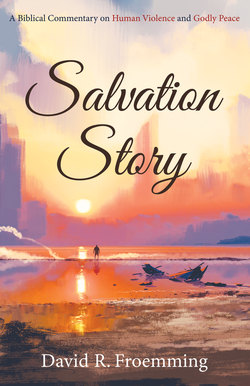Читать книгу Salvation Story - David R. Froemming - Страница 13
На сайте Литреса книга снята с продажи.
Exodus 8 and 9
Оглавление1 Then the LORD said to Moses, “Go to Pharaoh and say to him, ‘Thus says the LORD: Let my people go, so that they may worship me. 2 If you refuse to let them go, I will plague your whole country with frogs. 3 The river shall swarm with frogs; they shall come up into your palace, into your bedchamber and your bed, and into the houses of your officials and of your people, and into your ovens and your kneading bowls. 4 The frogs shall come up on you and on your people and on all your officials.’”
16 Then the LORD said to Moses, “Say to Aaron, ‘Stretch out your staff and strike the dust of the earth, so that it may become gnats throughout the whole land of Egypt.’” 17 And they did so; Aaron stretched out his hand with his staff and struck the dust of the earth, and gnats came on humans and animals alike; all the dust of the earth turned into gnats throughout the whole land of Egypt.
Exodus 9:24 there was hail with fire flashing continually in the midst of it, such heavy hail as had never fallen in all the land of Egypt since it became a nation. 25 The hail struck down everything that was in the open field throughout all the land of Egypt, both human and animal; the hail also struck down all the plants of the field, and shattered every tree in the field.
Exodus lists nine nature plagues in all, and then concludes with a tenth plague that copies the violence done to the Hebrews at the start of this story—the death of the firstborn, only now among the Egyptians. In between the ninth and tenth plagues is the celebration of Passover, a ritual meal in Chapter 12, so that the Israelites may always remember their slavery and the God who led them to freedom. Then the drama concludes with one more attempt by Pharaoh to destroy the Hebrews as they leave. Again nature, the water of the Red Sea, swallows Pharaoh’s army.
This same theme of nature keeping the ever expanding power of humans in check was already used in Genesis 7—the story of the great flood and Noah. Here again, it was the wicked warrior heroes whom God did away with through a great flood—Chapter 6. Paul Ricœur has made the observation that while other neighbors of the Israelites had flood stories, the flood stories of the Israelites differed in one very significant way. Ricœur observes that in primitive myths such as the Babylonian’s Enuma elish human violence is due to humans copying the violent powers they find in nature.34 This confirms Girard’s observation that behind the gods in the warrior myths are real human victims of violence.35 However, Ricœur notes that in the biblical flood accounts, it is human violence that initiates the response of nature. Human violence is exposed in the story as being responsible for nature’s response.36
Think of the climate change debate today. As it turns out, the biblical salvation story holds humans accountable for nature’s response. As argued earlier by Walter Wink, the biblical worldview is integral, where humans are tied in with nature and evolution. Humanity cannot claim to be outside of the loop of what is happening in nature. To argue as such is to take the position of primitive pagan religions and abandon the worldview of the bible! The biblical worldview is much more akin to evolution than it is to pagan mythology. On this point the work of Richard Dawkins on the dynamics of evolution is well worth our observation. In his book The Selfish Gene, Dawkins observes that ultimately evolution does not reward those who constantly cheat and abuse power. Rather, in evolution cooperation and mutual assistance is the larger strategy for the continuation of life.37
Returning to the salvation story, the Israelites once set free will regress to their idols after leaving Egypt. And today we regress in our religious life as we fashion gods in our own images of power, and in our own images of conformity to unjust powers that have once again blinded us through rivalry—our in-groups and out-groups, those we copy, and those we resent for not conforming to our copying. Law alone and law telling us not to make idols is only part of the salvation story’s response to the problem of human mimesis. The prophets, as we have already seen in Isaiah, take up the problem of idolatry again, and as we shall see, point us to the other part of the equation—receiving a new identity from the God who is becoming.
34. Ricœur, The Symbolism of Evil, 175–217.
35. Girard, The Scapegoat, 48–49.
36. Ricœur, The Symbolism of Evil, 175–217.
37. Dawkins, The Selfish Gene, 202–33.
